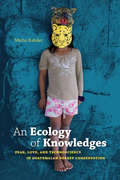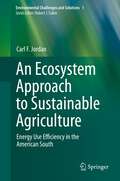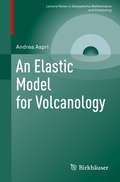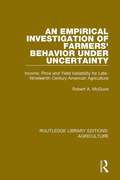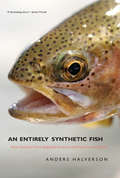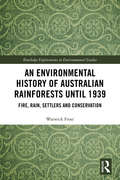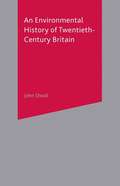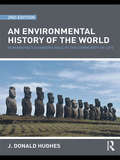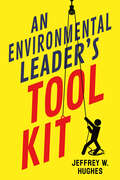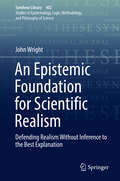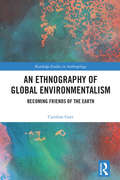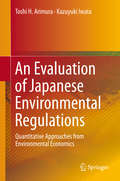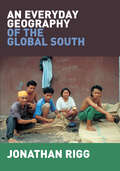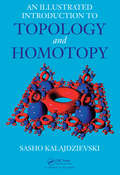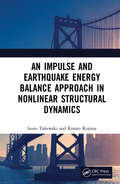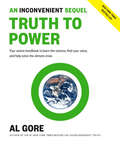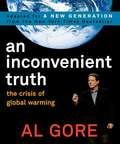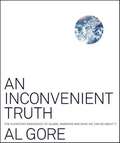- Table View
- List View
An Ecology of Knowledges: Fear, Love, and Technoscience in Guatemalan Forest Conservation (Experimental Futures)
by Micha RahderGuatemala's Maya Biosphere Reserve (MBR), the largest protected area in Central America, is characterized by rampant violence, social and ethnic inequality, and rapid deforestation. Faced with these threats, local residents, conservationists, scientists, and NGOs in the region work within what Micha Rahder calls “an ecology of knowledges,” in which interventions on the MBR landscape are tied to differing and sometimes competing forms of knowing. In this book, Rahder examines how technoscience, endemic violence, and an embodied love of wild species and places shape conservation practices in Guatemala. Rahder highlights how different forms of environmental knowledge emerge from encounters and relations between humans and nonhumans, institutions and local actors, and how situated ways of knowing impact conservation practices and natural places, often in unexpected and unintended ways. In so doing, she opens up new ways of thinking about the complexities of environmental knowledge and conservation in the context of instability, inequality, and violence around the world.
An Ecosystem Approach to Sustainable Agriculture: Energy Use Efficiency in the American South (Environmental Challenges and Solutions #1)
by Carl F. JordanModern industrial agriculture is not sustainable because of its heavy reliance on petroleum, a non-renewable source of the energy used in farming, and because of pollution caused by petroleum products such as fertilizers and pesticides. A systems analysis of farming suggests that agriculture will be more sustainable when services of nature, such as nutrient recycling by soil micro-organisms and natural controls of insects, replace the services now provided by energy from petroleum. Examples are drawn from the Southeastern USA, but lessons learned can be applied worldwide.
An Elastic Model for Volcanology (Lecture Notes in Geosystems Mathematics and Computing)
by Andrea AspriThis monograph presents a rigorous mathematical framework for a linear elastic model arising from volcanology that explains deformation effects generated by inflating or deflating magma chambers in the Earth’s interior. From a mathematical perspective, these modeling assumptions manifest as a boundary value problem that has long been known by researchers in volcanology, but has not, until now, been given a thorough mathematical treatment. This mathematical study gives an explicit formula for the solution of the boundary value problem which generalizes the few well-known, explicit solutions found in geophysics literature. Using two distinct analytical approaches—one involving weighted Sobolev spaces, and the other using single and double layer potentials—the well-posedness of the elastic model is proven. An Elastic Model for Volcanology will be of particular interest to mathematicians researching inverse problems, as well as geophysicists studying volcanology.
An Empirical Investigation of Farmers Behavior Under Uncertainty: Income, Price and Yield Variability for Late-Nineteenth Century American Agriculture (Routledge Library Editions: Agriculture #12)
by Robert A. McGuireThis study, first published in 1985, aims to provide objective measures of the risks associated with various crops and livestock in the late nineteenth century and to examine two important issues in American economic history. Knowledge of these risks if a necessity to the profession, if analyses of the uncertainties of postbellum agriculture are to continue. Without this knowledge, assertions which have little or no empirical content will continue to be made. This title will be of great interest to students of economics and agriculture.
An End State Methodology for Identifying Technology Needs for Environmental Management, with an Example from the Hanford Site Tanks
by Committee on Technologies for Cleanup of High-Level Waste in Tanks in the DOE Weapons ComplexThe National Academies Press (NAP)--publisher for the National Academies--publishes more than 200 books a year offering the most authoritative views, definitive information, and groundbreaking recommendations on a wide range of topics in science, engineering, and health. Our books are unique in that they are authored by the nation's leading experts in every scientific field.
An Entertainment for Angels: Electricity in the Enlightenment
by Patricia FaraCharacterizing electricity as "the greatest scientific invention of the Enlightenment," Fara (history of science, U. of Cambridge, UK) reconstructs the history of the discovery of electricity that pre- existed Benjamin Franklin's oft-cited kite. It is a history in which the instruments largely preceded the theory and "there was no clear path of development." Nevertheless, the development of those instruments, especially air pumps and Leyden jars, was absolutely necessary for later discoveries about electricity. Annotation ©2004 Book News, Inc., Portland, OR (booknews.com)
An Entirely Synthetic Fish
by Anders HalversonAnders Halverson provides an exhaustively researched and grippingly rendered account of the rainbow trout and why it has become the most commonly stocked and controversial freshwater fish in the United States. Discovered in the remote waters of northern California, rainbow trout have been artificially propagated and distributed for more than 130 years by government officials eager to present Americans with an opportunity to get back to nature by going fishing. Proudly dubbed "an entirely synthetic fish" by fisheries managers, the rainbow trout has been introduced into every state and province in the United States and Canada and to every continent except Antarctica, often with devastating effects on the native fauna. Halverson examines the paradoxes and reveals a range of characters, from nineteenth-century boosters who believed rainbows could be the saviors of democracy to twenty-first-century biologists who now seek to eradicate them from waters around the globe. Ultimately, the story of the rainbow trout is the story of our relationship with the natural world--how it has changed and how it startlingly has not.
An Environmental History of Australian Rainforests until 1939: Fire, Rain, Settlers and Conservation (Routledge Explorations in Environmental Studies)
by Warwick FrostThis book provides a comprehensive environmental history of how Australia’s rainforests developed, the influence of Aborigines and pioneers, farmers and loggers, and of efforts to protect rainforests, to help us better understand current issues and debates surrounding their conservation and use. While interest in rainforests and the movement for their conservation are often mistakenly portrayed as features of the last few decades, the debate over human usage of rainforests stretches well back into the nineteenth century. In the modern world, rainforests are generally considered the most attractive of the ecosystems, being seen as lush, vibrant, immense, mysterious, spiritual and romantic. Rainforests hold a special place; both providing a direct link to Gondwanaland and the dinosaurs and today being the home of endangered species and highly rich in biodiversity. They are also a critical part of Australia’s heritage. Indeed, large areas of Australian rainforests are now covered by World Heritage Listing. However, they also represent a dissonant heritage. What exactly constitutes rainforest, how it should be managed and used, and how much should be protected are all issues which remain hotly contested. Debates around rainforests are particularly dominated by the contradiction of competing views and uses – seeing rainforests either as untapped resources for agriculture and forestry versus valuing and preserving them as attractive and sublime natural wonders. Australia fits into this global story as a prime example but is also of interest for its aspects that are exceptional, including the intensity of clearing at certain periods and for its place in the early development of national parks. This book will be of great interest to students and scholars of Environmental History, Australian History and Comparative History.
An Environmental History of Latin America
by Shawn William MillerThis book narrates the mutually mortal historical contest between humans and nature in Latin America. Covering a period that begins with Amerindian civilizations and concludes in the region's present urban agglomerations, the work offers an original synthesis of the current scholarship on Latin America's environmental history and argues that tropical nature played a central role in shaping the region's historical development. Seeing Latin America's environmental past from the perspective of many centuries illustrates that human civilizations, ancient and modern, have been simultaneously more powerful and more vulnerable than previously thought.
An Environmental History of Russia
by Paul Josephson Nicolai Dronin Aleh Cherp Ruben Mnatsakanian Dmitry Efremenko Vladislav LarinThe former Soviet empire spanned eleven time zones and contained half the world's forests; vast deposits of oil, gas and coal; various ores; major rivers such as the Volga, Don and Angara; and extensive biodiversity. These resources and animals, as well as the people who lived in the former Soviet Union – Slavs, Armenians, Georgians, Azeris, Kazakhs and Tajiks, indigenous Nenets and Chukchi – were threatened by environmental degradation and extensive pollution. This environmental history of the former Soviet Union explores the impact that state economic development programs had on the environment. The authors consider the impact of Bolshevik ideology on the establishment of an extensive system of nature preserves, the effect of Stalinist practices of industrialization and collectivization on nature, and the rise of public involvement under Khrushchev and Brezhnev, and changes to policies and practices with the rise of Gorbachev and the break-up of the USSR.
An Environmental History of Twentieth-Century Britain
by John SheailEnvironmental history - the history of the relationship between people and the natural world - is a dynamic and increasingly important field. In An Environmental History of Twentieth-Century Britain, John Sheail breaks new ground in illustrating how some of the most pressing concerns came to be recognised, and a response made. Much use is made of archival sources in tracing a number of key issues, including: * management of change by central and local government * the manner in which natural processes were incorporated in projects to protect personal and public health, and ultimately environmental health * new beginnings in forestry * the emergence of a third force alongside farming and forestry in the countryside * management of a transport revolution, and mitigation of environmental hazards Such instances of policy-making are reviewed within the wider context of a growing awareness, both on the part of government and business, of the role of environmental issues in the creation of wealth and social well-being for us all. An Environmental History of Twentieth-Century Britain is essential reading for all those concerned with these issues.
An Environmental History of the World: Humankind's Changing Role in the Community of Life
by J. Donal Hughes J. Donald HughesThis second edition of An Environmental History of the World continues to present a concise history, from ancient to modern times, of the interactions between human societies and the natural environment, including the other forms of life that inhabit our planet. Throughout their evolutionary history, humans have affected the natural environment, sometimes with a promise of sustainable balance, but also in a destructive manner. This book investigates the ways in which environmental changes, often the result of human actions, have caused historical trends in human societies. This process has happened in every historical period and in every part of the inhabited earth. The book is organized into ten chapters. The main chapters follow a chronological path through the history of mankind, in relationship to ecosystems around the world. The first explains what environmental history is, and argues for its importance in understanding the present state of the world's ecological problems. Chapters two through eight form the core of the historical analysis, each concentrating on a major period of human history (pre-civilized, early civilizations, classical, medieval, early modern, early and later twentieth century, and contemporary) that has been characterized by large-scale changes in the relationship between human societies and the biosphere, and each gives several case studies that illustrate significant patterns occurring at that time. The chapters covering contemporary times discuss the physical impacts of the huge growth in population and technology, and the human responses to these problems. Our moral obligations to nature and how we can achieve a sustainable balance between technology and the environment are also considered. This revised second edition takes account of new research and the course of history containing new sections on global warming, the response of New Orleans to the hurricanes Katrina and Rita, and the experience of the Dutch people in protecting their low-lying lands against the encroachments of rivers, lakes, and the North Sea. New material is also offered on the Pacific Islands, including the famous case of Easter Island. This is an original work that reaches further than other environmental histories. Rather than looking at humans and the environment as separate entities, this book places humans within the community of life. The relationship between environmental thought and actions, and their evolution, is discussed throughout. Little environmental or historical knowledge is assumed from the reader in this introduction to environmental history. We cannot reach a useful understanding of modern environmental problems without the aid of perspective provided by environmental history, with its illustrations of the ways in which past decisions helped or hindered the interaction between nature and culture. This book will be influential and timely to all interested in or researching the world in which we live.
An Environmental History of the World: Humankind's Changing Role in the Community of Life (Routledge Studies In Physical Geography And Environment Ser. #Vol. 2)
by J. Donald HughesThis second edition of An Environmental History of the World continues to present a concise history, from ancient to modern times, of the interactions between human societies and the natural environment, including the other forms of life that inhabit our planet. Throughout their evolutionary history, humans have affected the natural environment, sometimes with a promise of sustainable balance, but also in a destructive manner. This book investigates the ways in which environmental changes, often the result of human actions, have caused historical trends in human societies. This process has happened in every historical period and in every part of the inhabited earth. The book is organized into ten chapters. The main chapters follow a chronological path through the history of mankind, in relationship to ecosystems around the world. The first explains what environmental history is, and argues for its importance in understanding the present state of the world's ecological problems. Chapters two through eight form the core of the historical analysis, each concentrating on a major period of human history (pre-civilized, early civilizations, classical, medieval, early modern, early and later twentieth century, and contemporary) that has been characterized by large-scale changes in the relationship between human societies and the biosphere, and each gives several case studies that illustrate significant patterns occurring at that time. The chapters covering contemporary times discuss the physical impacts of the huge growth in population and technology, and the human responses to these problems. Our moral obligations to nature and how we can achieve a sustainable balance between technology and the environment are also considered. This revised second edition takes account of new research and the course of history containing new sections on global warming, the response of New Orleans to the hurricanes Katrina and Rita, and the experience of the Dutch people in protecting their low-lying lands against the encroachments of rivers, lakes, and the North Sea. New material is also offered on the Pacific Islands, including the famous case of Easter Island. This is an original work that reaches further than other environmental histories. Rather than looking at humans and the environment as separate entities, this book places humans within the community of life. The relationship between environmental thought and actions, and their evolution, is discussed throughout. Little environmental or historical knowledge is assumed from the reader in this introduction to environmental history. We cannot reach a useful understanding of modern environmental problems without the aid of perspective provided by environmental history, with its illustrations of the ways in which past decisions helped or hindered the interaction between nature and culture. This book will be influential and timely to all interested in or researching the world in which we live.
An Environmental Leader's Tool Kit
by Jeffrey W. HughesIf you want to tackle an environmental problem in your neighborhood but do not know where to start, An Environmental Leader's Tool Kit can help. In this handbook, Jeffrey W. Hughes shares the proven strategies you need to step up and get meaningful action done.From designing a pilot study to managing contentious public meetings and more, Hughes walks you through the essentials of effective place-based environmental efforts. Among the tools you will find here are worksheets to kickstart brainstorming, appendixes that demystify jargon you might encounter, and illuminating, real-life examples. Down-to-earth and stimulating, An Environmental Leader's Tool Kit is a launchpad for those ready to make a difference now.
An Epistemic Foundation for Scientific Realism: Defending Realism Without Inference To The Best Explanation (Synthese Library #402)
by John WrightThis monograph develops a new way of justifying the claims made by science about phenomenon not directly observable by humans, such as atoms and black holes. It details a way of making inferences to the existence and properties of unobservable entities and states of affairs that can be given a probabilistic justification. The inferences used to establish realist claims are not a form of, and neither do they rely on, inference to the best explanation. Scientific Realism maintains that scientific theories and hypotheses refer to real entities, forces, and relations, even if one cannot examine them. But, there are those who doubt these claims. The author develops a novel way of defending Scientific Realism against a range of influential attacks. He argues that in some cases, at least, we can make probabilistically justifiable inferences from observed data to claims about unobservable, theoretical entities. He shows how this enables us to place some scientific realist claims on a firmer epistemological footing than has previously been the case. This also makes it possible to give a unified set of replies to the most common objections to Scientific Realism. The final chapters apply the developed conceptual apparatus to key cases from the history of science and from recent science. One example concerns realism with respect to atoms. Another looks at inferences from recent astronomical data to conclusions about the size and shape of those parts of the universe lying beyond that which we can observe.
An Ethnography of Global Environmentalism: Becoming Friends of the Earth (Routledge Studies in Anthropology)
by Caroline GattBased on nine years of research, this is the first book to offer an in-depth ethnographic study of a transnational environmentalist federation and of activists themselves. The book presents an account of the daily life and the ethical strivings of environmental activist members of Friends of the Earth International (FoEI), exploring how a transnational federation is constituted and maintained, and how different people strive to work together in their hope of contributing to the creation of "a better future for the globe." In the context of FoEI, a great diversity of environmentalisms from around the world are negotiated, discussed and evolve in relation to the experiences of the different cultures, ecosystems and human situations that the activists bring with them to the federation. Key to the global scope of this project is the analysis of FoEI experiments in models for intercultural and inclusive decision-making. The provisional results of FoEI’s ongoing experiments in this area offer a glimpse of how different notions of the environment, and being an environmentalist, can come to work together without subsuming alterity.
An Evaluation of Japanese Environmental Regulations: Quantitative Approaches from Environmental Economics
by Toshi H. Arimura Kazuyuki IwataFocusing on air pollution, energy efficiency and climate change, this book provides an introduction to Japan's environmental policies and regulations, and offers economic analyses and RIAs (Regulatory Impact Analysis) of environmental regulations implemented or planned by the national and local governments. The opening chapter reviews environmental economics and outlines the current status of RIAs in Japan. Chapter 2 analyzes the NOx-PM Act, which prohibits the use of old and polluting vehicles in metropolitan areas. Chapter 3 examines a Tokyo metropolitan government regulation which requires installation of pollution control equipment in older trucks that fail to meet emission standards. Chapter 4 traces the impact of the NOx-PM Act on the used car market and used vehicle exports. Chapter 5 presents an economic analysis of a highway toll reduction, revealing an unexpected negative social impact: it increased traffic congestion and associated environmental problems. The final three chapters address policies and regulations related to energy efficiency and climate change Chapter 6 evaluates the effectiveness of Japan's Energy Conservation Act, originally introduced in 1979 and amended numerous times to address climate change. Chapter 7 anticipates the impact of a proposed economy-wide carbon tax, using input-output analysis to assess short-term economic impacts in each sector. Also presented here is an examination of the effectiveness of a reduced carbon tax for energy-intensive industries, with a discussion of the impact of the proposal on households. The final chapter discusses the role and limitations of economic models for evaluating Japan's mid-term GHG (Greenhouse Gas) emission target during the post-Kyoto period. This is the first book to evaluate Japanese environmental policies from an economic perspective, using a variety of current quantitative approaches. Its findings and suggestions will benefit students, policy makers and government officials in developing and developed countries where the public faces similar environmental problems.
An Event-Based Science Module: Earthquake!
by Russell G. WrightEarthquake! is an earth-science unit that follows the Event-Based Science (EBS) Instructional Model and is built around simulations of real-life events and experiences that affected people's lives and environments dramatically.
An Everyday Geography of the Global South
by Jonathan RiggTaking a broad perspective of livelihoods, this book draws on more than ninety case studies from thirty-six countries across Asia, Africa and Latin America to examine how people are engaging and living with modernity. This extends from changes in the ways that households operate, to how and why people take on new work and acquire new skills, how migration and mobility have become increasingly common features of existence, and how aspirations and expectations are being reworked under the influence of modernization. To date, this is the only book which takes such an approach to building an understanding of the global South. By using the experience of the non-Western world to illuminate and inform mainstream debates in geography, and in beginning from the lived experiences of ‘ordinary’ people, this book provides an alternative insight into a range of geographical debates. The clarity of argument and its use of detailed case studies makes this book an invaluable resource for students.
An Illustrated Guide to Furniture History
by Joclyn M. OatsAn Illustrated Guide to Furniture History provides upper-level students and instructors with an alternative visual analytical approach to learning about furniture history from Antiquity to Postmodernism. Following an immersive teaching model, it presents a Nine-Step Methodology to help students strengthen their visual literacy and quickly acquire subject area knowledge. Moving chronologically through key periods in furniture history and interior design, such as the Renaissance, the Arts and Crafts Movement, and Modernism, it traverses Europe to America to present a comprehensive foundational guide to the history of furniture design. Part I addresses furniture within the context of the built environment, with chapters exploring the historical perspective, construction principles, and the categorization of furniture. In Part II, the author visually depicts the structural organization of the methodological process, a three-category framework: History, Aesthetics, and Visual Notes. The chapters in this part prepare the reader for the visual analysis that will occur in the final section of the book. The book is lavishly illustrated in full color with over 300 images to reinforce visual learning and notation. A must-have reference and study guide for students in industrial and product design, interior design, and architecture.
An Illustrated Introduction to Topology and Homotopy
by Sasho KalajdzievskiAn Illustrated Introduction to Topology and Homotopy explores the beauty of topology and homotopy theory in a direct and engaging manner while illustrating the power of the theory through many, often surprising, applications. This self-contained book takes a visual and rigorous approach that incorporates both extensive illustrations and full proofs
An Impulse and Earthquake Energy Balance Approach in Nonlinear Structural Dynamics
by Izuru Takewaki Kotaro KojimaProblems in nonlinear structural dynamics and critical excitation with elastic-plastic structures are typically addressed using time-history response analysis, which requires multiple repetitions and advanced computing. This alternative approach transforms ground motion into impulses and takes an energy balance approach. This book is accessible to undergraduates, being based on the energy balance law and the concepts of kinetic and strain energies, and it can be used by practitioners for building and structural design. This presentation starts with simple models that explain the essential features and extends in a step-by-step manner to more complicated models and phenomena.
An Inconvenient Sequel: Your Action Handbook to Learn the Science, Find Your Voice, and Help Solve the C limate Crisis
by Al GoreA New York Times bestseller!The follow up to the #1 New York Times bestselling An Inconvenient Truth and companion to Vice President Al Gore’s new documentary, An Inconvenient Sequel: Truth to Power, this new book is a daring call to action. It exposes the reality of how humankind has aided in the destruction of our planet and delivers hope through groundbreaking information on what you can do now.Vice President Gore, one of our environmental heroes and a leading expert in climate change, brings together cutting-edge research from top scientists around the world; approximately 200 photographs and illustrations to visually articulate the subject matter; and personal anecdotes and observations to document the fast pace and wide scope of global warming. He presents, with alarming clarity and conclusiveness (and with humor, too) that the fact of global climate change is not in question and that its consequences for the world we live in will be assuredly disastrous if left unchecked. Follow Vice President Gore around the globe as he tells a story of change in the making. He connects the dots of Zika, flooding, and other natural disasters we’ve lived through in the last 10+ years—and much more. The book also offers a comprehensive how-to guide on exactly how we can change the course of fate. With concrete, actionable advice on topics ranging from how to run for office to how to talk to your children about climate change, An Inconvenient Sequel will empower you to make a difference—and lets you know how exactly to do it. Where Gore’s first documentary and book took us through the technical aspects of climate change, the second documentary is a gripping, narrative journey that leaves you filled with hope and the urge to take action immediately. This book captures that same essence and is a must-have for everyone who cares deeply about our planet.
An Inconvenient Truth: The Crisis of Global Warming (Adapted)
by Jane O'Connor Al GoreFormer Vice President Al Gore's New York Times #1 bestselling book is a daring call to action, exposing the shocking reality of how humankind has aided in the destruction of our planet and the future we face if we do not take action to stop global warming. Now, Viking has adapted this book for the most important audience of all: today's youth, who have no choice but to confront this climate crisis head-on. Dramatic full-color photos, illustrations, and graphs combine with Gore's effective and clear writing to explain global warming in very real terms: what it is, what causes it, and what will happen if we continue to ignore it. An Inconvenient Truth will change the way young people understand global warming and hopefully inspire them to help change the course of history. .
An Inconvenient Truth: The Planetary Emergence of Global Warming and What We Can Do About It
by Al GoreOur climate crisis may appear to be happening slowly but in fact it is happening very quickly, and has become a true planetary emergency.
